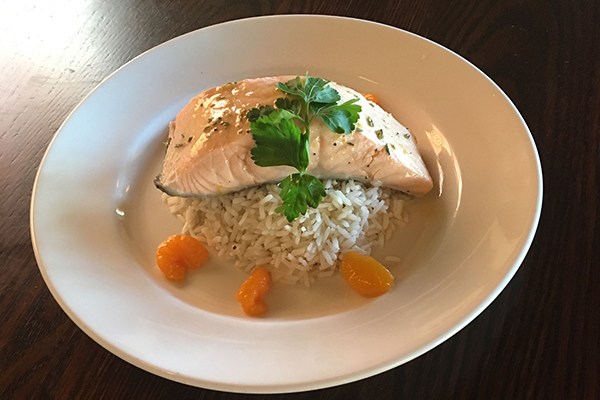
By Chef Neil Magbanua

This month’s subject will not be a specific recipe but a cooking technique. It is rarely used in modern restaurant kitchens anymore because of its slow process and relatively undramatic look. I am referring to poaching.
By definition, poaching is cooking a product slowly while fully submerged in some sort of flavorful liquid.
For the sake of this column, we will be concentrating on water-based poaching, as oil-poaching does add some potentially unwanted calories to the food. While animals such as chicken, pork and beef are good candidates for poaching, they are more suited for dry cooking techniques such as grilling. For your money, fish and seafood are, in my opinion, better poaching candidates. It also makes sense to me as these animals originate from water.
Have you ever eaten shrimp where it had the texture of a rubber band or eaten a piece of fish that was supposedly “poached” and it tasted dry, mealy or overcooked? The reason for that is poor temperature control.
You must realize that heat is heat, whether it is dry or wet. The same temperature rules apply in poaching as in roasting. Too high a heat or too long in the heat will result in overcooked food.
For poaching success, the rules are simple.
- Make sure your poaching liquid has flavor. It should have a good amount of seasoning since you will not be seasoning the food before it goes in the liquid.
- Only use enough liquid to cover the food. This is not like cooking pasta where you use a lot of liquid to cook the product. Water is very dense, and it holds onto heat very well, so too much liquid could overcook your food even if you turn the burner off.
- You have picked and seasoned your flavorful water based cooking liquid (beer, stock, wine, etc.), chosen your cooking vessel (pot, sauté pan, etc.), and food to be cooked (shrimp, salmon, tuna, etc.). Now, simply place the food in the vessel and cover with just enough liquid.
- Remove the food and bring liquid to a boil. That’s right, a full boil. The purpose of this step is to add the food and liquid first to make sure you have just the right amount of liquid. Then, removing the food and bringing the liquid to a boil will ensure that any bacteria hitching a ride on the surface of your food is eliminated, without overcooking your food.
- Finally, add your food to the boiling liquid and back the heat down, cooking slowly until the internal target temperature of the food is reached. For shrimp and most fish, that’s about 155 degrees. Once your food reaches the temperature of your liquid, in theory, you could keep it there for a very long time. The result should be a moist and flavorful, healthy meal.
Good luck and good eating.
Neil Magbanua is chef at Arroyo Grille at Ak-Chin Southern Dunes.
This column appears in the April issue of InMaricopa.












![Maricopa’s ‘TikTok Rizz Party,’ explained One of several flyers for a "TikTok rizz party" is taped to a door in the Maricopa Business Center along Honeycutt Road on April 23, 2024. [Monica D. Spencer]](https://www.inmaricopa.com/wp-content/uploads/2024/04/spencer-042324-tiktok-rizz-party-flyer-web-218x150.jpg)

![Maricopa restauranteur makes Food Network connection [Namkeen Dhaba]](https://www.inmaricopa.com/wp-content/uploads/2024/04/439456716_377105198650519_7536248579664805896_n-100x70.jpg)


